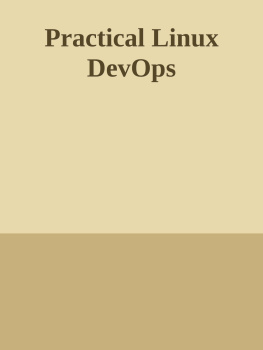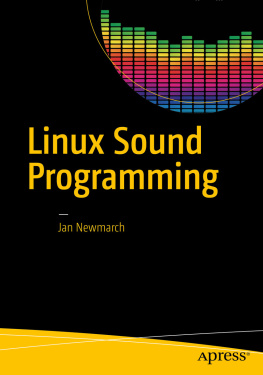In this chapter, we deepen the knowledge of how the computer can be prepared to capture incoming sound or produced sound, how the sound is represented internally, and how the data arrives at ThMAD. We distinguish between the obvious air pressure elongation versus time representation, and the power versus frequency representation, or spectrum .
Preparing for Sound Input
After you purchase a PC or laptop with Ubuntu Linux, or after you have Ubuntu Linux installed on your PC, you have basically two optionsyou can use external audio sources or you can let the sound play from the computer. As for the latter, you could use the CD player of your PC, you could play some files from a USB stick or your hard disk, or you could stream audio files via the Internet or some other means.
Note that other Linux distributions might work as well. Give it a trychances are good that youll find similar programs, tools, and settings to accomplish the same thing.
If you want to use external audio sources, you need a microphone or a sound card with a line-in to connect to. Especially for laptops, the built-in microphones are not of the highest quality, but they might be enough for your purposes. You actually dont want to accurately reproduce the sound, but react to it, and for this aim, having perfectly linear input curves is not too important. On the other hand, if you dont want to lose important impulses from the basses, which can happen with cheap microphones, getting yourself a decent microphone might help you avoid surprises. Also, bear in mind that audio visualizations might be brittle to the structure of the incoming sound under certain circumstances.
Usually you want to avoid that and the overall outcome should be interesting for any kind of music input. This is easy enough to check with different recordings. But if, for example, the basses never make their way through the audio hardware to a suitable extent, because your microphone misses the basses, your rendering pipeline might lack reactiveness to an important part of the incoming sound. If instead for external sound input you just connect some audio source to the line-in jack of your computer, you are automatically on the safe side.
If you want to play CDs using your computers CD player , or play audio files or streamed audio contents, e.g., using your browser, chances are good you dont have to do anything but start suitable programs or let the operating system do it for you automatically. For larger sound file collections, a program for administering them might be handy. RhythmBox, which is preinstalled on Ubuntu, is a good option.
The current version 1.0.0 of ThMAD primarily depends on PulseAudio, which is an audio routing server that handles all sound streams inside your computer. It knows everything thats captured or recorded, and everything thats played. Ubuntu Linux comes with PulseAudio preinstalled and automatically started; for other Linux distributions you may have to install it first.
ThMAD can also connect to ALSA, which is a low-level technology that talks to the sound hardware, and it can connect to JACK, which is a sound server that music professionals usually prefer. It is, however, considerably more difficult to use those options compared to PulseAudio, so we will as a sort of standard case use PulseAudio in the text.
For a graphical description of the standard PulseAudio sound chain, see Figure .
Figure 1-1.
The PulseAudio sound server inside Ubuntu
Understanding Sound Structure
Sound is about air pressure oscillations that are received by your ears. From a mathematical or physical point of view, there are different representations for soundthe time-elongation (or time-pressure) representation and the frequency-power representation. Both of these are discussed in the following sections.
Time-Elongation Representation
On a diagram with the x-axis denoting the time and the y-axis denoting the pressure, the time-elongation representation might, for a sine wave, look like Figure .
In computer systems, we need a digital representation for this sine wave. The idea is as follows: we divide the time into small time steps, say 44,100 steps per second, and for each time step, we write down the current air pressure, or y-value, and save it inside an array. This is sometimes called analog-to-digital conversion (ADC) . Note that 44,100 is a widely adopted industry standard, for example, its used with music CDs. Because we have two ears and like stereo, we do that conversion twice, for the left ear and the right ear. By that means, we end up with 88,200 numbers, which digitally represent one second of stereo sound. For the pressure or y-value representation, we use integer values (-32,768 up to 32,767), with the lower value representing a negative pressure offset, so maybe 0.997 bars, and the higher value representing a positive pressure offset, say 1.003 bars.
According to a scaling we can freely define, these could be mapped to 0.997 bars y=-1000 and 1.003 bars y=+1000. All the other numbers are mean pressures between these values. Of course we could use number ranges other than -32,768 32,767 , but the range we chose here is internally represented by exactly two bytes of data, and computers like that very much. It is also a trade-off: fewer different values means less resolution and poorer quality, and more different values means higher storage need.
Of course, in reality music is stored in lots of different formats, including MP3, Ogg Vorbis and others, mainly for reasons of saving space. The 88,200 numbers per second add up quite rapidly. But in case of letting an application like ThMAD access PulseAudio data, it will receive the data in an uncompressed and untransformed, raw format. This is nice, since then ThMAD doesnt need extra logic to handle different sound formats.
Frequency-Power Representation
A practically less obvious representation of sound consists of writing down the frequency distribution at each instant of time.
Consider the time range [10s;10.1s] when listening to some music. Instead of reporting the air pressure amplitudes at each instant, e.g., 10.000s, 10.001s, 10.002s, we report the frequency mixture of the tones that arrive in our ears during some time range [10s;10.1s]. A 100Hz + b 200Hz + c 300Hz + , where x Hz means a sine oscillation frequency of x per second, and the a, b, c, are weights or power coefficients. The lower the number, the smaller the contribution and the higher, the larger the contribution.
Doing this in a mathematically concise way is called Fourier Transformation , and it turns out that it is a perfectly equivalent way of describing sound. In fact, if we have sound in a pressure versus time representation, we can apply a Fourier Transformation to transfer this into a power versus frequency representation without losing any information. That means the process is reversible and we have something like an Inverse Fourier Transformation to go back the other way. We dont show the mathematical details here; you can find a lot about that in other books and on the Internet.











![Dave Mathews [Dave Mathews] - Panda3D 1.6 Game Engine](/uploads/posts/book/118496/thumbs/dave-mathews-dave-mathews-panda3d-1-6-game.jpg)






